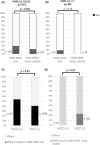Analysis of genetic factors associated with fatty liver disease-related hepatocellular carcinoma
- PMID: 37644826
- PMCID: PMC10524060
- DOI: 10.1002/cam4.6410
Analysis of genetic factors associated with fatty liver disease-related hepatocellular carcinoma
Abstract
Aim: Single-nucleotide polymorphisms (SNPs) in PNPLA3 and hydroxysteroid 17-beta dehydrogenase 13 (HSD17B13) genes are associated with fatty liver disease (FLD) progression and carcinogenesis. In the present study, we evaluated the characteristics of Japanese FLD patients according to HSD17B13 polymorphisms.
Methods: We enrolled 402 patients who were clinically and pathologically diagnosed with FLD (alcoholic: 63 cases, nonalcoholic: 339 cases) at our hospital in 1990-2018 (228 males; median age: 54.9 [14.6-83.6] years). FLD patients with HSD17B13 A/A (212 cases) and others (A/AA or AA/AA; 190 cases) were compared.
Results: Compared to patients with HSD17B13 A/A and others, those with the A/A genotype showed increased incidence of hepatocellular carcinoma (HCC) (A/A vs. others; 18.4% vs. 9.5%, p = 0.01), cardiovascular diseases (14.2% vs. 4.2%, p < 0.01), and hypertension (56.6% vs. 47.4%, p = 0.06). In patients without A/A, the HCC incidence was significantly reduced in those with alcohol-related FLD, fibrosis-4 index <2.67, and the PNPLA3 CC genotype; however, there was no significant difference in nonalcoholic-FLD. Patients without HSD17B13 A/A showed severe steatosis (77% vs. 88.6%, p < 0.01). New HCC developed in 11 cases and the 5-year incidence rate of HCC was 3.3% in patients with both PNPLA3 GG/GC and HSD17B13 A/A, which was significantly higher than the rate for those with other SNP profiles (0.6%, p = 0.03).
Conclusions: Inhibiting HSD17B13 activity may prevent HCC development, particularly in alcohol-related FLD and low-risk patients. Therefore, combinations of SNPs and other risk factors can be used for screening FLD-HCC.
Keywords: 17-beta dehydrogenase 13; fatty liver disease; hepatocellular carcinoma; patatin-like phospholipase 3.
© 2023 The Authors. Cancer Medicine published by John Wiley & Sons Ltd.
Conflict of interest statement
KT is the recipient of research funding from Sumitomo Dainippon Pharma Co., Ltd., Astellas Pharma Inc., Eisai Co., Ltd., Taiho Pharmaceutical Co., Ltd., Chugai Pharmaceutical Co., Ltd., Daiichi Sankyo Pharmaceutical Co., Ltd., AbbVie GK, Takeda Pharmaceutical Co. Ltd., Asahi Kasei Corporation. Ajinomoto Co., Inc., and Otsuka Pharmaceutical Co., Ltd.
Figures



Similar articles
-
Attenuated effect of PNPLA3 on hepatic fibrosis by HSD17B13 in Japanese patients with non-alcoholic fatty liver disease.Liver Int. 2020 Jul;40(7):1686-1692. doi: 10.1111/liv.14495. Epub 2020 May 12. Liver Int. 2020. PMID: 32342668
-
Carriage of the PNPLA3 rs738409 C >G polymorphism confers an increased risk of non-alcoholic fatty liver disease associated hepatocellular carcinoma.J Hepatol. 2014 Jul;61(1):75-81. doi: 10.1016/j.jhep.2014.02.030. Epub 2014 Mar 6. J Hepatol. 2014. PMID: 24607626
-
Genetic Variation in HSD17B13 Reduces the Risk of Developing Cirrhosis and Hepatocellular Carcinoma in Alcohol Misusers.Hepatology. 2020 Jul;72(1):88-102. doi: 10.1002/hep.30996. Epub 2020 May 20. Hepatology. 2020. PMID: 31630428
-
Association between rs738409 polymorphism in patatin-like phospholipase domain-containing protein 3 (PNPLA3) gene and hepatocellular carcinoma susceptibility: Evidence from case-control studies.Gene. 2019 Feb 15;685:143-148. doi: 10.1016/j.gene.2018.11.012. Epub 2018 Nov 4. Gene. 2019. PMID: 30403964 Review.
-
Hepatocellular carcinoma in nonalcoholic fatty liver: role of environmental and genetic factors.World J Gastroenterol. 2014 Sep 28;20(36):12945-55. doi: 10.3748/wjg.v20.i36.12945. World J Gastroenterol. 2014. PMID: 25278690 Free PMC article. Review.
Cited by
-
Meta-Analysis: Effects of Steatotic Liver Disease-Associated Genetic Risk Alleles on Longitudinal Outcomes.Aliment Pharmacol Ther. 2025 Aug;62(3):244-276. doi: 10.1111/apt.70256. Epub 2025 Jun 28. Aliment Pharmacol Ther. 2025. PMID: 40580198 Free PMC article.
-
Disrupting Poly(ADP-ribosyl)ating Pathway Creates Premalignant Conditions in Mammalian Liver.Int J Mol Sci. 2023 Dec 6;24(24):17205. doi: 10.3390/ijms242417205. Int J Mol Sci. 2023. PMID: 38139034 Free PMC article.
-
From adiposity to steatosis: metabolic dysfunction-associated steatotic liver disease, a hepatic expression of metabolic syndrome - current insights and future directions.Clin Diabetes Endocrinol. 2024 Dec 2;10(1):39. doi: 10.1186/s40842-024-00187-4. Clin Diabetes Endocrinol. 2024. PMID: 39617908 Free PMC article. Review.
-
Interplay between gut microbiome, host genetic and epigenetic modifications in MASLD and MASLD-related hepatocellular carcinoma.Gut. 2024 Dec 10;74(1):141-152. doi: 10.1136/gutjnl-2024-332398. Gut. 2024. PMID: 38950910 Free PMC article. Review.
-
Genome-wide association study identifies high-impact susceptibility loci for HCC in North America.Hepatology. 2024 Jul 1;80(1):87-101. doi: 10.1097/HEP.0000000000000800. Epub 2024 Feb 20. Hepatology. 2024. PMID: 38381705 Free PMC article.
References
-
- Eslam M, Valenti L, Romeo S. Genetics and epigenetics of NAFLD and NASH: clinical impact. J Hepatol. 2018;68:268‐279. - PubMed
-
- Liu YL, Patman GL, Leathart JB, et al. Carriage of the PNPLA3 rs738409 C >G polymorphism confers an increased risk of non‐alcoholic fatty liver disease associated hepatocellular carcinoma. J Hepatol. 2014;61:75‐81. - PubMed
MeSH terms
LinkOut - more resources
Full Text Sources
Medical
Miscellaneous

